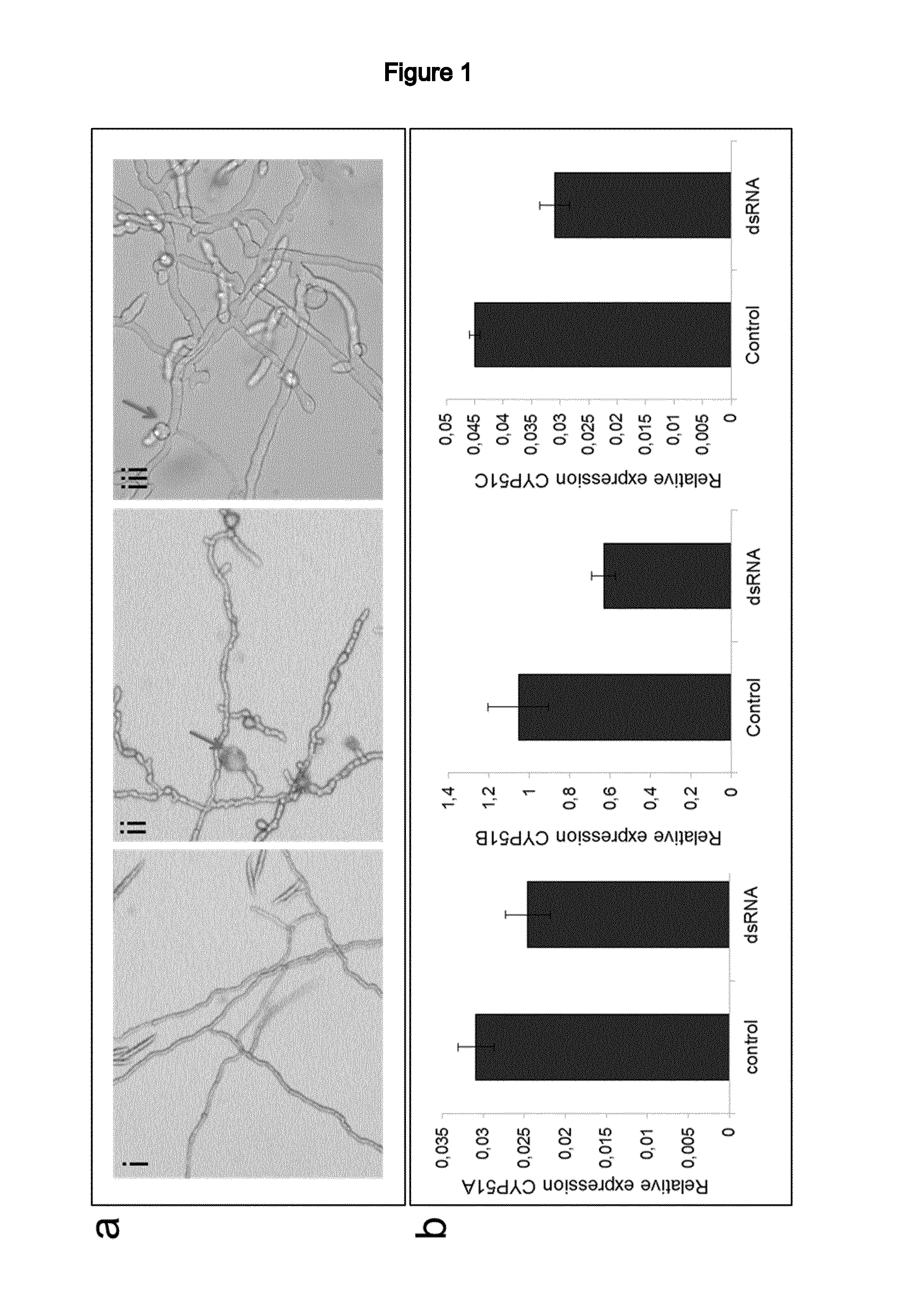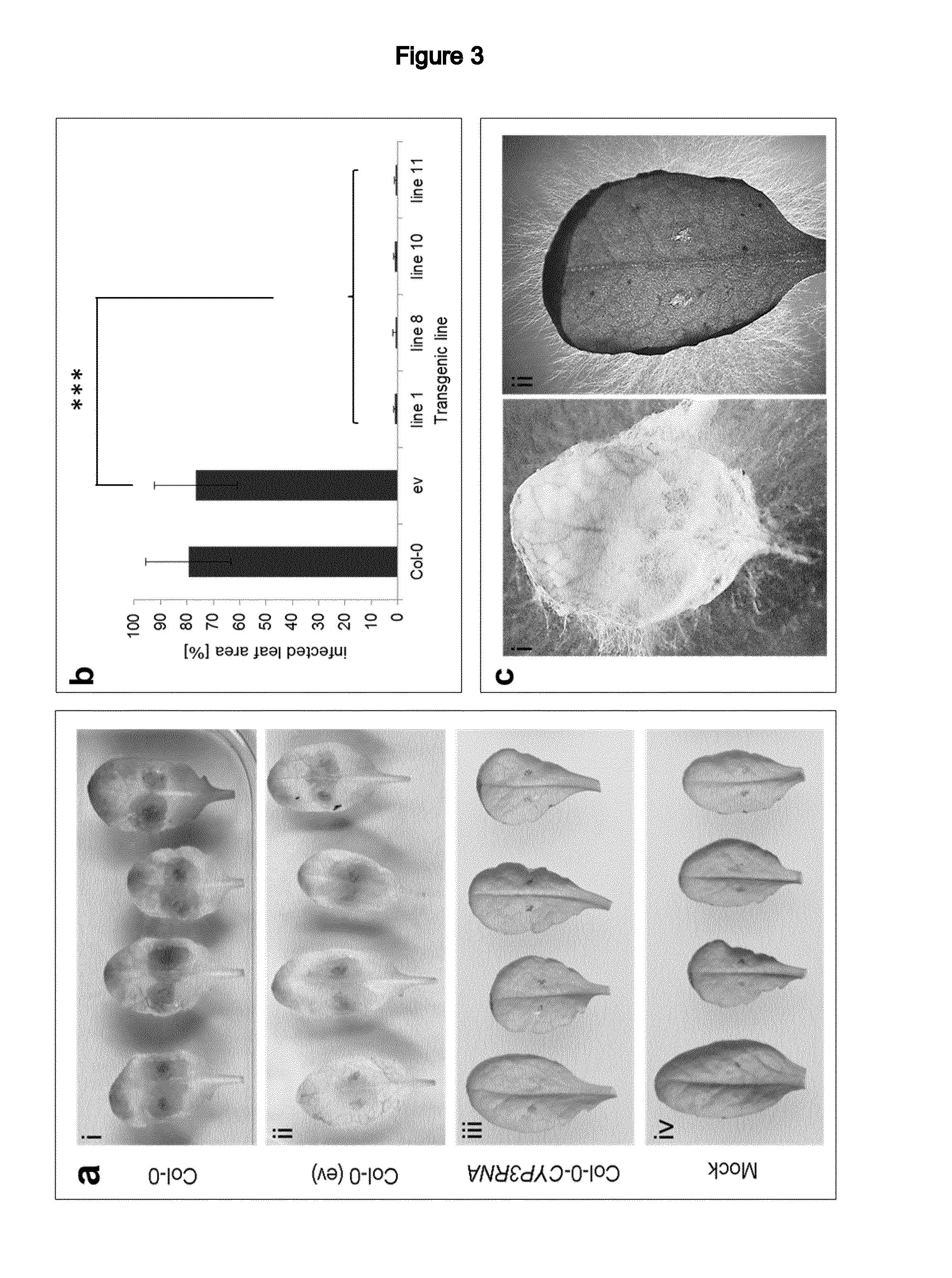Rnai for the control of phytopathogenic fungi and oomycetes by inhibiting the expression of cyp51 genes
a technology of oomycetes and phytopathogenic fungi, which is applied in the field of double-stranded rna (dsrna)mediated gene silencing, can solve the problems of serious economic losses, food safety compromises, and plant diseases caused by phytopathogenic fungi and oomycetes
- Summary
- Abstract
- Description
- Claims
- Application Information
AI Technical Summary
Benefits of technology
Problems solved by technology
Method used
Image
Examples
example 1
Inhibition of Fungal Growth and Silencing of Fg CYP51 Genes by Direct Application of dsRNA
[0163]A 791 bp dsRNA (CYP3RNA) complementary to all three fungal CYP51 genes (FIG. 5) was generated. Microscopic analysis of Fg macroconidia treated with CYP3RNA revealed swelling of hyphal tips by 48 h post treatment (hpt, data not shown). By 72 hpt, the morphological changes had become more pronounced, particularly at hyphal tips (FIG. 1a,ii). In comparison, no such swelling was detected in the mock-treated control (FIG. 1a,i). Since CYP51 proteins are the target of azole fungicides, also the phenotype of Fg macroconidia treated with tebuconazole was monitored. Fg macroconidia treated with tebuconazole (5 mg / I) exhibited a phenotype comparable to that elicited by CYP3RNA treatment (FIG. 1a,iii).
[0164]The similar phenotype of CYP3RNA- and tebuconazole-treated Fg indicated that the dsRNA silenced the expression of one or more CYP51 genes. This was confirmed by quantifying the transcript levels ...
example 2
Expression of CYP3RNA in Planta Confers Resistance to Fg
[0167]Arabidopsis thaliana Col-0 plants were transformed with either p7U10-CYP3RNA, which contains two inverted 35S promoters that drive the constitutive production of sense and antisense copies of CYP3RNA, or an empty vector (ev) control (FIGS. 7 and 8). Resistance to Fg was assessed by inoculating detached leaves of 5-week-old Arabidopsis T2 plants (expressing CYP3RNA) and the respective Arabidopsis Col-0 ev control plants with 5×104 Fg macroconidia per ml (cf. method v) above).
[0168]At 3 days post inoculation (dpi), both wild-type (wt) Col-0 and the ev control line showed water-soaked lesions with chlorotic or necrotic lesions; these are typical symptoms of a Fg infestation (FIG. 3a,i-ii). In marked contrast, four independent Arabidopsis T2 lines containing the CYP3RNA silencing construct (L1, L8, L10, L11) showed no disease symptoms, and their leaves were indistinguishable from those of the mock-inoculated controls (FIG. 3a...
example 3
Fg Resistance in the CYP3RNA-Expressing Lines is Due to HIGS of the CYP51 Genes
[0172]To assess whether HIGS of the CYP51 genes was responsible for Fg resistance in the CYP3RNA-expressing lines, quantitative RT-PCR analysis of total RNA from the Fg inoculated leaves of CYP3RNA-expressing and ev control plants was performed 3 dpi (cf. method (vi) above). The relative transcript levels of Fg CYP51A, Fg CYP51B and Fg CYP51C were reduced on average by 92%, 89%, and 77%, respectively, in samples from CYP3RNA-expressing lines (L1, L8, L10, and L11), as compared with the ev control line (FIGS. 5-7).
[0173]It was further assessed whether this reduction in Fg CYP51 transcripts was associated with the production of corresponding siRNAs. In Northern analyses using CYP3RNA as the probe, siRNAs corresponding to the targeted CYP51 sequences in both Fg-infested and uninfested leaves from CYP3RNA-expressing plants were detected (FIG. 8). By contrast, these siRNAs were not observed in the leaves of wt...
PUM
| Property | Measurement | Unit |
|---|---|---|
| volume | aaaaa | aaaaa |
| volume | aaaaa | aaaaa |
| temperature | aaaaa | aaaaa |
Abstract
Description
Claims
Application Information
 Login to View More
Login to View More - R&D
- Intellectual Property
- Life Sciences
- Materials
- Tech Scout
- Unparalleled Data Quality
- Higher Quality Content
- 60% Fewer Hallucinations
Browse by: Latest US Patents, China's latest patents, Technical Efficacy Thesaurus, Application Domain, Technology Topic, Popular Technical Reports.
© 2025 PatSnap. All rights reserved.Legal|Privacy policy|Modern Slavery Act Transparency Statement|Sitemap|About US| Contact US: help@patsnap.com



